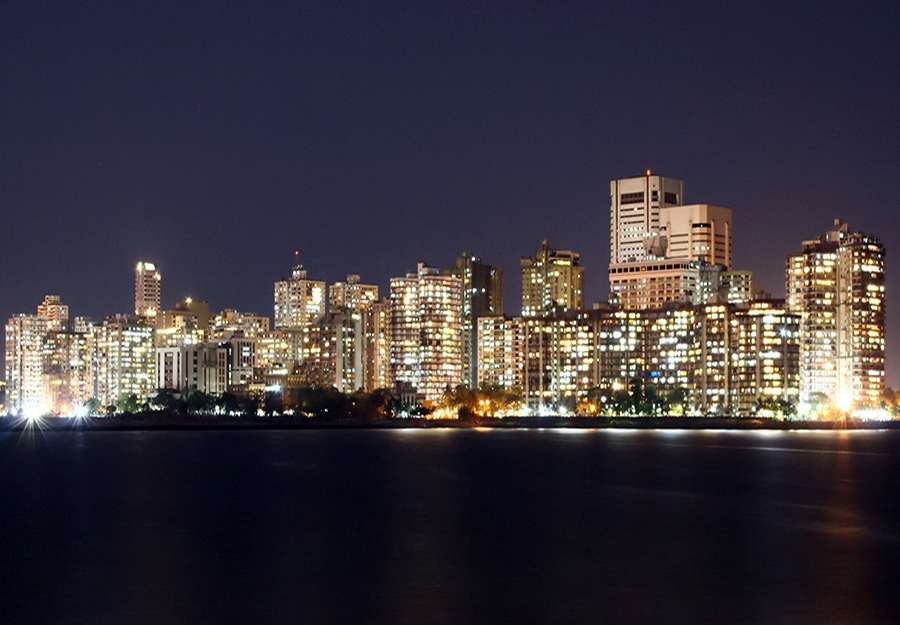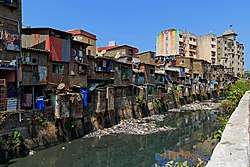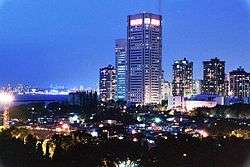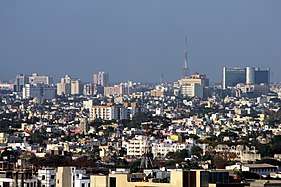Urbanisation in India

Urbanization in India began to accelerate after independence, due to the country's adoption of a mixed economy, which gave rise to the development of the private sector. Urbanisation is taking place at a faster rate in India. Population residing in urban areas in India, according to 1901 census, was 11.4%.[1] This count increased to 28.53% according to 2001 census, and crossing 30% as per 2011 census, standing at 31.16%.[2][3] According to a survey by UN State of the World Population report in 2007, by 2030, 40.76% of country's population is expected to reside in urban areas.[4] As per World Bank, India, along with China, Indonesia, Nigeria, and the United States, will lead the world's urban population surge by 2050.[2]
Mumbai saw large scale rural-urban migration in the 20th century.[see main] Mumbai, in 2018, accommodates 22.1 million people, and is the largest metropolis by population in India, followed by Delhi with 28 million inhabitants. Witnessing the fastest rate of urbanisation in the world, as per 2011 census, Delhi's population rises by 4.1%, Mumbai's by 3.1% and Kolkata's by 2% as per 2011 census compared to 2001 census.
History
The transition period
After independence, India faced poverty, unemployment, and economic backwardness. The first Prime Minister of India, Pandit Jawaharlal Nehru, focused on the domain of science and technology.[5] The mixed economy system was adopted, resulting in the growth of the Public sector in India crippling down the development of Indian economy leading to what is popularly known as Hindu rate of growth.[6]
Modern India
| Largest urban agglomerations in India by population (2011 census)[7] | |||||||||||
|---|---|---|---|---|---|---|---|---|---|---|---|
| Rank | City Name | State/Territory | Population | Rank | City Name | State/Territory | Population | ||||
| 1 | Mumbai | Maharashtra | 18,414,288 | 11 | Kanpur | Uttar Pradesh | 2,920,067 | ||||
| 2 | Delhi | Delhi | 16,314,838 | 12 | Lucknow | Uttar Pradesh | 2,901,474 | ||||
| 3 | Kolkata | West Bengal | 14,112,536 | 13 | Nagpur | Maharashtra | 2,497,777 | ||||
| 4 | Chennai | Tamil Nadu | 8,696,010 | 14 | Ghaziabad | Uttar Pradesh | 2,358,525 | ||||
| 5 | Bengaluru | Karnataka | 8,499,399 | 15 | Indore | Madhya Pradesh | 2,167,447 | ||||
| 6 | Hyderabad | Telangana | 7,749,334 | 16 | Coimbatore | Tamil Nadu | 2,151,466 | ||||
| 7 | Ahmedabad | Gujarat | 6,352,254 | 17 | Kochi | Kerala | 2,117,990 | ||||
| 8 | Pune | Maharashtra | 5,049,968 | 18 | Patna | Bihar | 2,046,652 | ||||
| 9 | Surat | Gujarat | 4,585,367 | 19 | Kozhikode | Kerala | 2,030,519 | ||||
| 10 | Jaipur | Rajasthan | 3,073,350 | 20 | Thrissur | Kerala | 1,854,783 | ||||
The contribution of the agricultural sector to the GDP of India started to decline and the percentage contribution from secondary sector increased. The period after 1941, witnessed rapid growth of four metropolitan cities in India, which were Kolkata, Delhi, Mumbai, and Chennai.[8] The nation's economy saw a rise due to industrial revolution and the invention of new technologies increased the standard of living of people living in urban areas.[9] The growth of public sector resulted in development of public transport, roads, water supply, electricity, and hence the infrastructure of urban areas.
Maharashtra was the most urbanized state in India till 1991, stood behind Tamil Nadu in 2001 and third after it in 2011, with Kerala being second,[10] with the urban-total state population ratio. However, Maharashtra's urban population of 41 million, far exceeds that of Tamil Nadu which is at 27 million, as per the 2001 census.[11]
Causes of urbanisation in India
The main causes of urbanisation in India are:
- Expansion in government services, as a result of the Second World War
- Migration of people during the partition of India[12][13][14]
- The Industrial Revolution[15]
- Eleventh five-year plan that aimed at urbanisation for the economic development of India[16]
- Economic opportunities are just one reason people move into cities
- Infrastructure facilities in the urban areas[17]
- Growth of private sector after 1990 .[18]
- Growth of employment in cities is attracting people from rural areas as well as smaller cities to large towns. According to Mckinsey India's urban population will grow from 340 million in 2008 to 590 million in 2030.
- Therefore, it is being driven by economic compulsions where people move out for economic advancements to areas offering better job opportunities.
- It is also driven by land fragmentations, villages being erased due to roads and highway constructions, dam constructions and other activities.
Consequences of urbanization

Rapid rise in urban population, in India, is leading to many problems like increasing slums, decrease in standard of living in urban areas, also causing environmental damage.[19]
The Industrial Revolution of the 18th century caused countries like the United States and the United Kingdom to become superpowers, but conditions elsewhere are worsening. India's urban growth rate is 2.07%; seemingly insignificant compared to Rwanda, with 7.6%. India has around 300 million people living in metropolitan areas.[20] This has greatly increased housing issues: with overcrowded cities, many people are forced to live in unsafe conditions, such as illegal buildings. Water lines, roads and electricity are lacking in quality, resulting in a decline of living standards. It is also contributing to the issues presented by pollution.[21]
Urbanization also results in a disparity in the market, owing to the large demands of the growing population and the primary sector struggling to cope.[22]
Allan Chirare, 15 August 2015 quotes: "Urbanization is just becoming a disaster to the city of Mumbai in India."
It could be argued that urbanization impacts the migrants themselves on multiple levels. Networks of friends and family become support systems during the initial transformation phase and the struggle to find work in a fast-paced environment. Their struggles may take months, or even years, to adjust to the new surrounds in order to find a stable job. Migrants are responsible for supporting both themselves in the city and the family left at home.
Some of the positive effects resulting from rural to urban migration occur in the agrarian communities from which migrants came. Family members left at home, usually the elderly and young, are eased out of financial pressures as their relatives work to provide higher standards of living for their dependants. Their quality of life is often additionally improved by the provisions that the migrant sends back.
On the other hand, rural to urban migration poses a big challenge for the developing cities due to migrant populations flocking in. How will cities support it in terms of resources, land and space?
Urban unemployment
The National Sample Survey Organisation reported the following urban unemployment rates for the period July 2011–June 2012:[23]
| Category of persons | Male | Female | Person |
|---|---|---|---|
| Unemployment rate (per 1000 persons in the labour force) | 30 | 52 | 34 |
References
- ↑ Kamaldeo Narain Singh (1 January 1978). Urban Development In India. Abhinav Publications. ISBN 978-81-7017-080-8. Retrieved 13 June 2012.
- 1 2 Business Standard (15 June 2012). "Victims of urbanization: India, Indonesia and China". Rediff.com. Retrieved 15 June 2012.
- ↑ Datta, Pranati. "Urbanisation in India" (PDF). Infostat.sk. Retrieved 13 June 2012.
- ↑ "Urbanization in India faster than rest of the world". Hindustan Times. 27 June 2007. Retrieved 13 June 2012.
- ↑ N. M. Khilnani (1993). Socio-Political Dimensions of Modern India. M.D. Publications Pvt. Ltd. pp. 96–. ISBN 978-81-85880-06-8. Retrieved 15 June 2012.
- ↑ TR Jain; Mukesh Trehan; Ranju Trehan. Indian Economy and Business Environment (for BBA). FK Publications. pp. 250=. ISBN 978-81-87344-71-1. Retrieved 15 June 2012.
- ↑ "Table 3: Urban agglomerations having population 1 Lakh and above" (PDF). Provisional Population Totals. Government of India. Retrieved 2011-10-19.
- ↑ Viswambhar Nath; Surinder K. Aggarwal (1 January 2007). Urbanization, Urban Development, and Metropolitan Cities in India. Concept Publishing Company. pp. 3–. ISBN 978-81-8069-412-7. Retrieved 15 June 2012.
- ↑ "The Indian Industrial Revolution". Srcindore.org. Retrieved 15 June 2012.
- ↑ "Rural-Urban distribution of population" (PDF). Census of India Press Release. Retrieved 19 November 2013.
- ↑ "Urbanization" (PDF). Planning Commission (India). Retrieved 15 June 2012.
- ↑ Viswambhar Nath; Surinder K. Aggarwal (1 January 2007). Urbanization, Urban Development, and Metropolitan Cities in India. Concept Publishing Company. p. 6. ISBN 978-81-8069-412-7. Retrieved 13 June 2012.
- ↑ The Indian and Pakistan year book. Bennett, Coleman & Co. 1951. Retrieved 15 June 2012.
- ↑ Jonathan M. Harris; Tufts University. Global Development and Environment Institute (1 March 2001). A Survey of Sustainable Development: Social And Economic Dimensions. Island Press. pp. 142–. ISBN 978-1-55963-863-0. Retrieved 15 June 2012.
- ↑ N. T. K. Naik; S. Mansoor Rahman (1 January 2007). Urbanization of India. Serials Publications. ISBN 978-81-8387-078-8. Retrieved 15 June 2012.
- ↑ Amitabh Kundu. Trends and processes of urbanization in india. IIED. p. 1. GGKEY:NNAEQJ0WFTW. Retrieved 13 June 2012.
- ↑ Pradhan, Rudra Prakash. "Does infrastructure play role in urbanization: evidence from India". Indian Journal of Economics and Business via HighBeam Research.
- ↑ "Role of private sector in India's growth ~ Business News This Week". Businessnewsthisweek.com. 8 February 2009. Retrieved 21 June 2012.
- ↑ K. C. Sivaramakrishnan; Biplab Dasgupta; Mahesh N. Buch (1 January 1993). Urbanization in India: Basic Services and People's Participation. Concept Publishing Company. p. 2. ISBN 978-81-7022-480-8. Retrieved 13 June 2012.
- ↑ "AUICK Newsletter No.27". Auick.org. Retrieved 21 June 2012.
- ↑ Niu, Tong (18 January 2011). "Problems of Urbanisation in India". YouthKiAwaaz. Retrieved 15 June 2012.
- ↑ Javir. "Problems of Urbanization in India". Preserve Articles. Retrieved 15 June 2012.
- ↑ "Status of Urban Employment in the Country". PIB. 20 February 2014. Retrieved 21 February 2014.
Bibliography
- Ballhatchet, Kenneth; Harrison, John (1980). The City in South Asia: Pre-Modern and Modern. Curzon Press.

_2013-06-30_22-44.jpg)
